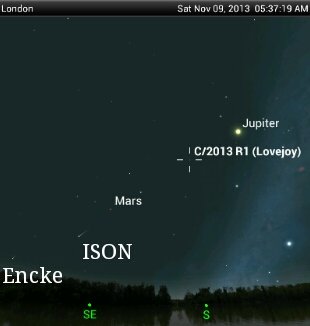

| Visitors Now: | |
| Total Visits: | |
| Total Stories: |

| Story Views | |
| Now: | |
| Last Hour: | |
| Last 24 Hours: | |
| Total: | |
Looks Like We Got Us A Comet Convoy…
Well, it seems that the much anticipated Comet ISON will have company when it’s in the sky later this year. Famed comet discoverer Terry Lovejoy has found another comet, and the latest Comet Lovejoy will be joining ISON in the northern sky in December. In fact, they will be keeping each other company from the start of November – a prospect which will have comet observers and astrophotographers alike drooling, I’m sure.
As this chart – created with the fantastic planetarium smartphone App “Sky Safari” shows – at the moment Comet Lovejoy is in the constellation of Monoceros, snuggling up next to Orion in the early morning sky…
…and it is far too faint to see through binoculars or even a small telescope, But that will change as the days and weeks pass, and by November it should be visible in more modest equipment. Initial calculations suggest the latest Lovejoy won’t reach naked eye visibility, reaching a maximum magnitude of between 8 and 9, but as comet experts and observers always say it’s almost impossible to try and predict what a comet is going to do, so the best thing is just to work out where it is going to be and go take a look at it yourself.
On November 29th, when ISON has rounded the Sun and, we hope, begins to unfurl a tail and become visible to the naked eye, Comet Lovejoy will be close by. Here’s what comet observers will be looking at and photographing then…
Note: you can see the Sky Safari software has shown where Comet ISON’s tail will be at that time, poking up from behind the horizon at the bottom left there, but there’s no way of knowing if it will actually be visible.
By mid-December, when many comet experts are predicting ISON may be at its best as it climbs up towards the stars of the Plough, Comet Lovejoy will be nearby…
That’s a pretty exciting prospect for comet observers. But what caught my eye was what we have a chance of seeing a month earlier, before dawn on the morning of November 9th. Given clear skies, and a lot of luck, we have a chance of seeing a veritable “Comet Convoy” as 3 comets line up with Mars and Jupiter in the south east before sunrise…
And how bright will they all be? Well, from the left, Comet Encke will be magnitude 6, ISON should be hovering around 6 or 7, and Lovejoy will be still very faint at around magnitude 9. That means, especially in a brightening sky, none of them will probably be visible to the naked eye, but this parade will have astrophotographers out in their thousands I should think, and comet observers will be giddy with excitement.








Interesting, Thanks! Are amateurs even seeing ISON yet, even with a scope?
Yes, it can be seen with amateur equipment now. Here are some images of it by amateurs, some taken as recent as Sept 7, 2013:
http://www.aerith.net/pictures/comet.html#2012S1
From the same site and another one below it, you can get info on all comets currently visible with amateur equipment:
http://www.aerith.net/comet/weekly/current.html
http://cometchasing.skyhound.com/
▶ Tolec speaks about Comet Ison, Xanterexx biosphere – YouTube http://bit.ly/1ehlqkX
Below is a link to the latest image of Comet ISON that I’ve found. It was taken by the Vatican Observatory’s 1.8 meter telescope in Arizona on September 12, 2013:
http://www.alpo-astronomy.org/alpo/?page_id=34&g2_itemId=5167
I watched as they sprayed (5 planes) over my house last night. (NH) I grabbed my camera and went and took a photo of the moon. I caught something. I tried sending it out on GLP and they banned me. So for anyone who like to see all the photos of whatever this thing was below the little moon…check it out here. Let me know what u think.
http://i1071.photobucket.com/albums/u502/Reptilian3/IMG_1374.jpg